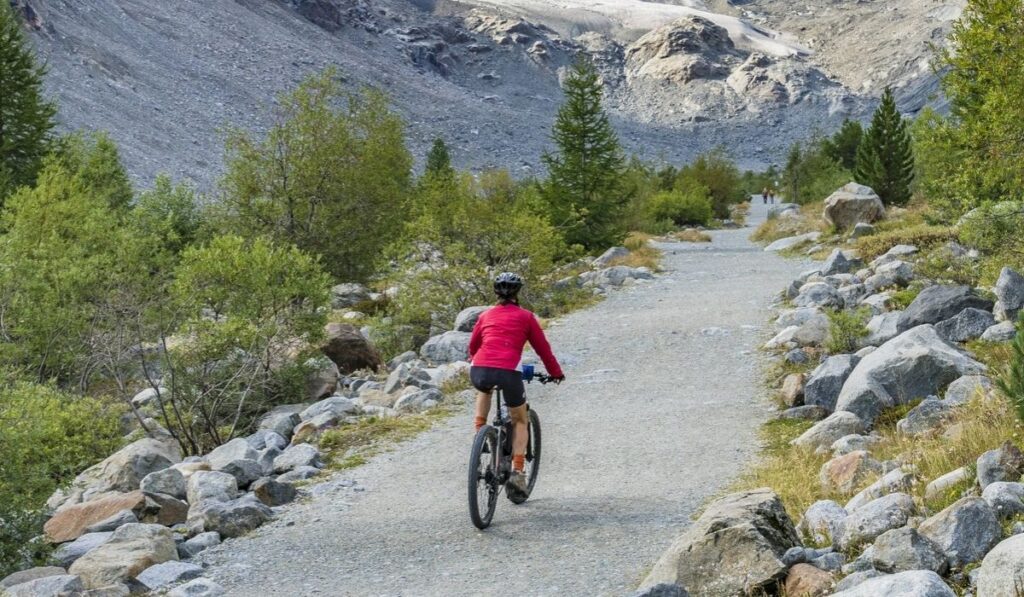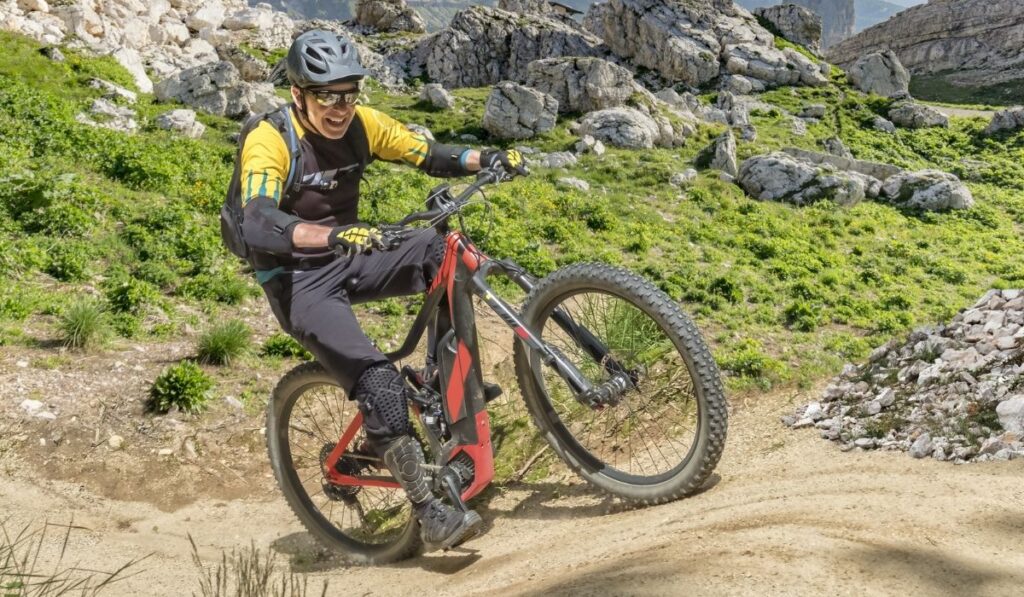Are you thinking of buying an e-bike, but not sure if they handle hills well? E-bikes can go uphill, and unlike traditional bikes, they do so effortlessly. Since they’re powered by both a motor and a battery, e-bikes can cycle over any hill.
With their motors and pedal assist features, E-Bikes can typically go up hills much faster and easier than traditional bikes. Swapping to a lower gear and helping out with pedal assist will minimize the effects of hills on your battery and range. Higher watt motors handle hills better.
Generally, e-bikes are expertly designed and electrically powered to climb hills better than a traditional bike. Riding uphill does require more power though, which is quite tasking on the battery and motor. But we’ll talk more about some tactics you can use to tackle all the hills you need to without running down your battery too quickly!
Riding E-Bikes Uphill

When riding e-bikes uphill, note that the steeper the hill, the more strain your motor experiences. Every bike behaves differently when its motor is strained, so you must keep this in mind when cycling.
Your effort and that of your motor keep your e-bike running because the bike’s motor works in conjunction with your pedaling. This means that when you stop pedaling, the motor stops too.
The strain then comes about when the engine reaches its maximum speed, usually about 15mph, thereby making the bike depend solely on your legs because the motor is too strained to assist you.
Using a mid-drive motor is perfect for off-road purposes and hills. The motor tackles steep hills efficiently, and with its featured riding modes, you can easily switch gears.
Switching the engine to lower gear powers the e-bike up any steep incline and enables longer rides on hills without overheating.
On the other hand, pedal-assist systems are not quite as strong as the gear systems when riding up a hill. They also tend to be slower, and even if there is a strong motor featured in the system, it just isn’t fit for hills compared to gears.
Moving on, below are a few tips to take note of when cycling up a hill:
- On gentle slopes, position your body neutrally.
- On steeper slopes, adjust your weight forward by resting into the handlebars with bent elbows. This assists the rear wheel with keeping the grip.
- Be alert, stick to your lane, and watch for obstacles ahead that may affect your motion.
- Try as much as possible to maintain a regular speed with little or no disturbance. This will enable your e-bike to go uphill way more easily.
Will Riding Uphill Slow The Bike Down?
Sure, but this depends on the grade of the motor of the e-bike. The e-bike may slow all the way down or even stop, but higher power motors that are greater than 500 watts will handle them easier.
Normally, an e-bike goes uphill three times faster than a regular bike would. So, if a rider pedals at 4 mph up an incline, the e-bike will go 12 mph. The rider gives off 100 watts while that of the motor could be 300 watts; this equals 400 watts.
This amount of power, when applied to level ground, would produce up to 20 mph speeds. Higher speeds require more power from the motor. Also, to decrease the likelihood of being extra slow while cycling uphill, try as much as possible to reduce the cargo you’re carrying.
Should You Pedal When Riding An E-Bike Uphill?
Absolutely, you should. It will save battery power and take the strain off the motor. Not pedaling means you want the motor to do all the work, which will strain the battery power.
Pedaling is another form of exercise that helps you save the bike’s battery and enjoy the fun involved. Although, if you do this a lot, it will make you sweaty, which might not be good if you’re commuting to work, except the hills are short.
Will Speeding Up Before A Hill Help?
Totally! This is because you start the hill with more momentum and power already. So, you want to speed up as much as you can, safely, ahead of a mountain.
Note that the average speed for going up steep hills ranges from 18 mph to 25 mph. This does not require you to use much energy or exertion, and even if you want to go faster, that’s not a problem.
Again, be aware that most bikes have the standard speed limit of 20 mph to 25 mph or even less, so going faster may require you to modify your e-bike’s motor to meet up with the speed you want.
What Gear Should You Ride Uphill In?

Gears on electric bikes not only make climbing hills way easier, but they also help in extending the bike’s battery life. And, just like on traditional bikes, the gears in e-bikes work the same way.
Setting your gear to a lower level enables the easy-pedaling of the e-bike. This causes more work for the motor and uses more of the battery’s power. On the other hand, setting your gear to a higher level makes you put more effort into pedaling, saving the motor from much work.
So when you are approaching a hill, you can switch your gear to a low level so the motor will do more work. But if the bike stops due to motor strain, and you can’t keep pedaling, it’s time to walk the rest of the way!
What Are Some Great E-Bikes For Steep Hills Or Commutes With Lots Of Hills?
Lectric XP 2.0
- Battery: 48V 9.6Ah (460 Wh)
- Motor Wattage: 500W (850 W peak)
- High Speed: 28 mph
The Lectric XP 2.0 is an upgraded version of the Lectric XP. It has average performance on smooth ground but has excellent control on steep terrains. The tires are a bit narrow, measuring 3 inches, and they are pretty solid enough to hold the strong frame.
The bike features various accessories but doesn’t include any hydraulic brakes, torque sensor, or speed transmission. It is foldable and the perfect choice as a starter e-bike with a removable battery that charges for 4-6 hours which can last for up to 45 miles.
NAKTO Electric Bike (on Amazon)
- Battery: 36 V 10.4 Ah
- Motor Wattage: 350 W
- High Speed: 20-25 mph
NAKTO Electric Bike is quite strong, and unlike Lectric XP 2.0, it has bigger tires. The tires are 4 inches and perfect for every terrain, including hills.
Just like Lectric, this one also has a removable battery with an almost equivalent battery voltage, though the battery can last for 25-35 miles when fully charged. With this bike, you can choose to either exercise or travel long distances.
PASELEC GS9 Electric Bike (on Amazon)
- Battery: 48 V 13 Ah
- Motor Wattage: 500 W
- High Speed: 25-28 mph
Of the three listed here, PASELEC GS9 has the largest battery capacity and can travel up to 50 miles when fully charged. The batteries are protected with an anti-lock mode to prevent theft and ensure their safety.
You can use this bike on off-roads, city roads, snow, beaches, and even jungle tracks. The wheels are 27.5 inches, with the perfect grip for rough terrains.
E-bikes have a price range of $900-2,000, but you don’t need to buy the most expensive e-bike to ride on hills. All you need is one that has a torque of 70 Nm (Newton-meters) or more, which provides more acceleration.
Before purchase, always take note of the number of watts and volts of the motor power. Also, keep in mind that bigger tires are always better for hills.
